MALEFICENT: MISTRESS OF EVIL is pure magic! A visually and emotionally exquisite tale that is simply beautiful.

Director Joachim Rønning wastes no time in bringing us up to speed with what’s been happening with Aurora, Maleficent, and Diaval since we last saw them, as we soar through the skies, swooping into the beauty and color and ethereal peace and tranquility of the Moors. Simply breathtaking. The elegance of the camera perfectly complements the fantastical nature of the faeries and little creatures of the Moors, immediately sweeping one into the magic of this world.
Since we last saw Aurora and Maleficent following the death of King Stefan, peace has come to the lands. Aurora has reigned as Queen of the Moors with Maleficent as overseer and protector. Unfortunately, the kingdom of Ulstead (and most particularly, Queen Ingrith), home to Aurora’s love Prince Philip, views Maleficent as a villain. Needless to say, when Aurora and Phillip become engaged, it doesn’t bode well with Maleficent. And with her attendance at a dinner at the castle with Ingrith and King John, it is clear that Ingrith is also less than thrilled with the union and not just because of Maleficent’s relationship with Aurora, but because of her own prejudice against anything or anyone non-human. A testament to the power of Michelle Pfeiffer’s performance as Ingrith is that one can almost hear her teeth gnashing behind a crippling smile.

With the engagement dinner anything but a pleasant experience, King John takes ill and falls into a deep sleep. Ironically, this is after Ingrith mentions Maleficent’s spinning wheel curse. With accusations being made across the table by both Maleficent and Ingrith, Maleficent takes her leave only to be felled by an iron bullet during a pre-planned attack by Ingrith’s right-hand servant, Gerda.
Plunging into the ocean, Maleficent is rescued by a winged creature similar to herself, Conall, leader of the Dark Fae, opening the door for us to learn about Maleficent and her kind, while setting the stage for a battle with Ingrith.
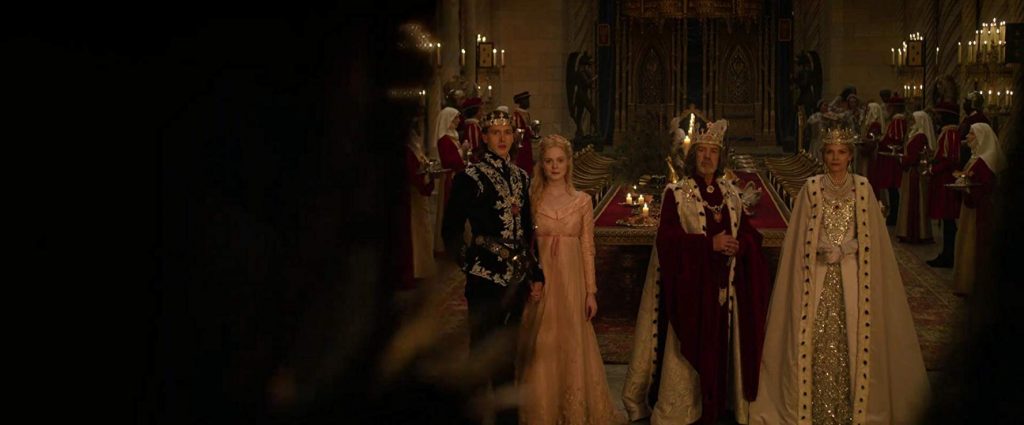
It’s the visual beauty of the film’s opening that allows us to feel the love that abounds in the lives of Maleficent and Aurora. And, of course, the theme of MALEFICENT: MISTRESS OF EVIL is not just about the magic of love, but a mother’s love, and the bond between a mother and daughter. It was Maleficent’s purity of love for Aurora that broke the “Sleeping Beauty” curse and scribes Micah Fitzerman-Blue, Noah Harpster, and Linda Woolverton carry that into this sequel and build upon it. We feel that bond and that love between Elle Fanning and Angelina Jolie as Aurora and Maleficent, respectively. We feel the pain and heartbreak of each when they argue like a true mother and daughter and we feel the explosion of love between them, particularly with sacrifices made by Maleficent for her little Beastie.
And of course, then there’s the added familial dynamic with Diaval who, together with Maleficent and Aurora, truly completes their little family and feels like Aurora’s big brother. The chemistry among Jolie, Fanning, and Sam Riley as Diaval is palpable and welcoming. Notable is also the love among the faerie folk and the self-sacrifices so many make to save others. There are so many precious moments within this film that all speak to love of others on so many levels, something we desperately need to see in films right now.

Piggybacking on the relationship and love between Maleficent and Aurora, we see a very different kind of love and dynamic between Ingrith and Phillip; it is one born more out of fear than out of the heart. And of course, there is the love between Aurora and Phillip which faces more obstacles to a happily ever after than most thanks to battle lines being drawn, literally and figuratively, by their mothers.
Notable, however, is the throughline of deception, discrimination, intolerance, and hatred fueling the movement of the story. Timely and topical in today’s world.
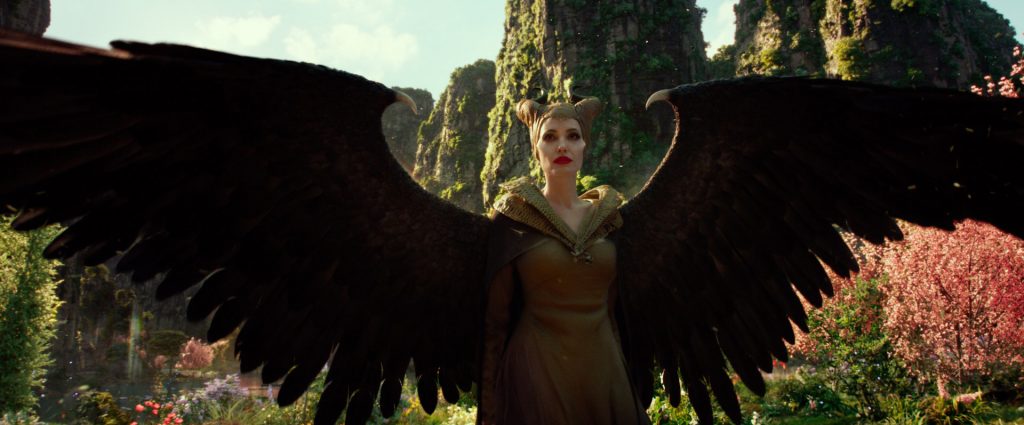
Visually expanding the world of Maleficent and Aurora, new creatures are introduced in the world of the Moors and the faerie folk, as well as Maleficent’s almost extinct kind, the Dark Fae. Adding depth to the overall story, the discovery of the Dark Fae backstory is engaging, visually appealing and dramatic, but feels shortchanged.

One of the most adorable new creatures to join the Moors is Pinto. Beyond cuteness! All of the wee faerie folk we see in this sequel are absolutely adorbsome. Enhancing this adorableness is the use of color, which is more noticeable in this sequel, creating even greater palpable joy at the beauty of this world. The night sequence of the faerie blooms that come from dead faeries is simply breathtaking.
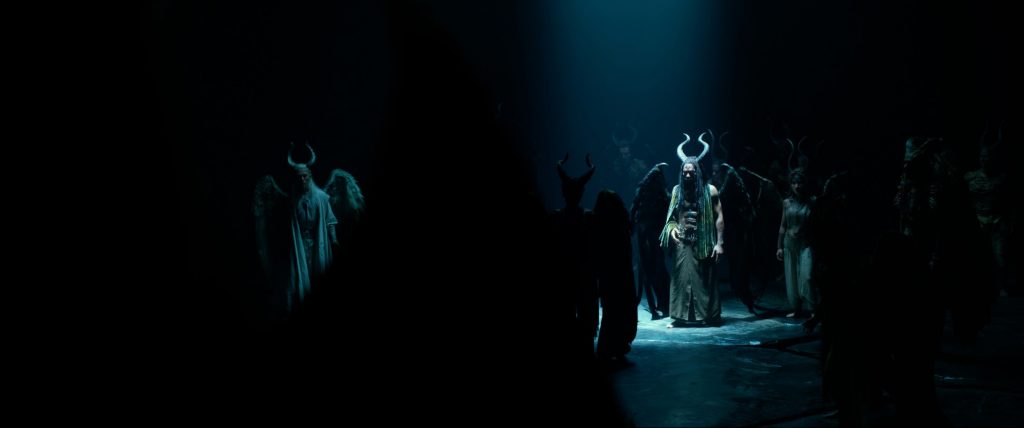
Battle sequences are outstanding. Flight choreography of the battle is well designed and effective. Nice twist with the story wherein the faeries own “magic” is pulverized into iron powder and when fired at a faerie, kills them but turns them into flora on their passing. A sweet touch and commentary on the circle of life.
Performances are, of course, solid. Angelina Jolie is the very embodiment of Maleficent. On equal performance footing are both Elle Fanning and Sam Riley as Aurora and Diaval. Harris Dickinson is an adequate Prince Phillip. Standout are Chiwetel Ejiofor and Ed Skrein who bring real heft and gravitas as Dark Fae, Conall and Borra, respectively.
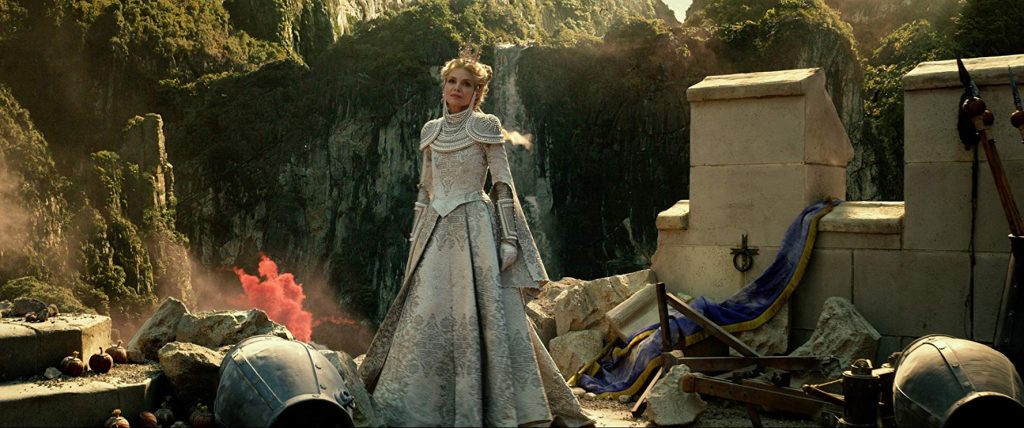
But the real scene stealer is Michelle Pfeiffer as Queen Ingrith. She gives new meaning to evil as we see the true evil of the film come through her character. So effective is her performance that there are moments one wants to reach through the screen and just grab her neck and the mountains of pearls adorning her.
Speaking of pearls, there should be an Oscar nomination on the horizon for costume designer Ellen Mirojnick. Costumes are gorgeous. From new looks for Maleficent in blacks but with the introduction of softer chiffons to the soft chiffon pastels for Aurora to the heavier brocade fabrics and highly structured forms of gowns for Ingrith to the incredible looks designed for Sam Riley’s Diaval, all are beauteous and award-worthy.
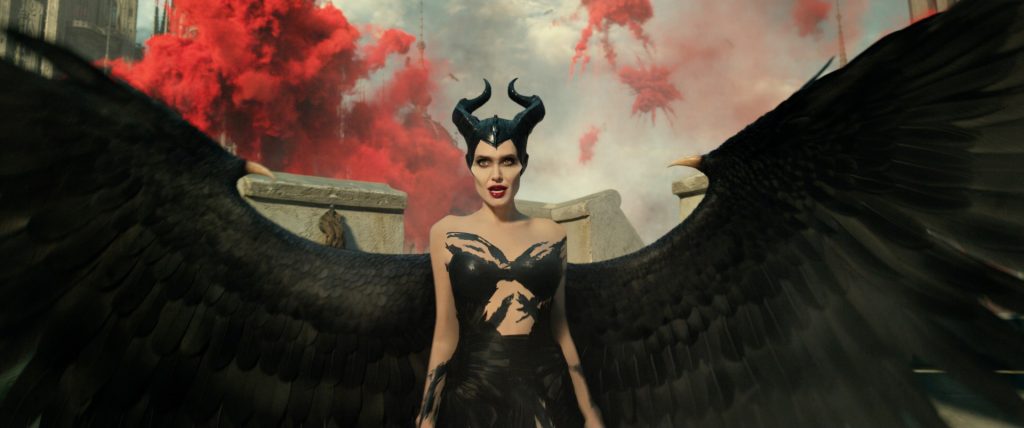
Production design of Patrick Tatopoulos is similarly excellent and showcased to its best advantage by cinematographer Henry Braham. It works to the film’s advantage to have a production designer with Tatopoulos’ background of creature creation and special effects as so much of MALEFICENT: MISTRESS OF EVIL rides on the world of the Moors and the differences with the “human” world. As a cinematographer, Braham is an interesting choice for the quieter and lighter and more naturally lit aspects of the film (How about Aurora’s moor castle under the pink blossomed tree and then the stunning and glorious wisteria garden she emerges from for her wedding??), but as we all know from his work on “Guardians of the Galaxy 2″, he can shoot action – which is where he is perfect for the amount of battle work and swooping and sweeping aerials. He also shoots exceedingly well knowing VFX is coming into play.
Geoff Zanelli’s score is beauteous, particularly in the opening fantasy sequence in the Moors as well as the composition over the end titles after the vocal song. Incredible. His musical arrangement and choice of instrumentation is very delicate, perfectly capturing the peace and harmony of what Aurora and Phillip have achieved, not to mention the peace that Maleficent has found as a true mother.
MALEFICENT: MISTRESS OF EVIL is pure magic from beginning to end.
Directed by Joachim Rønning
Written by Linda Woolverton, Noah Harpster and Micah Fitzerman-Blue, based on “La Belle Au Bois Dormant” written by Charles Perrault
Cast: Angelina Jolie, Elle Fanning, Sam Riley, Michelle Pfeiffer, Chiwetel Ejiofor, Ed Skrein, Harris Dickinson
by debbie elias, 09/29/2019











